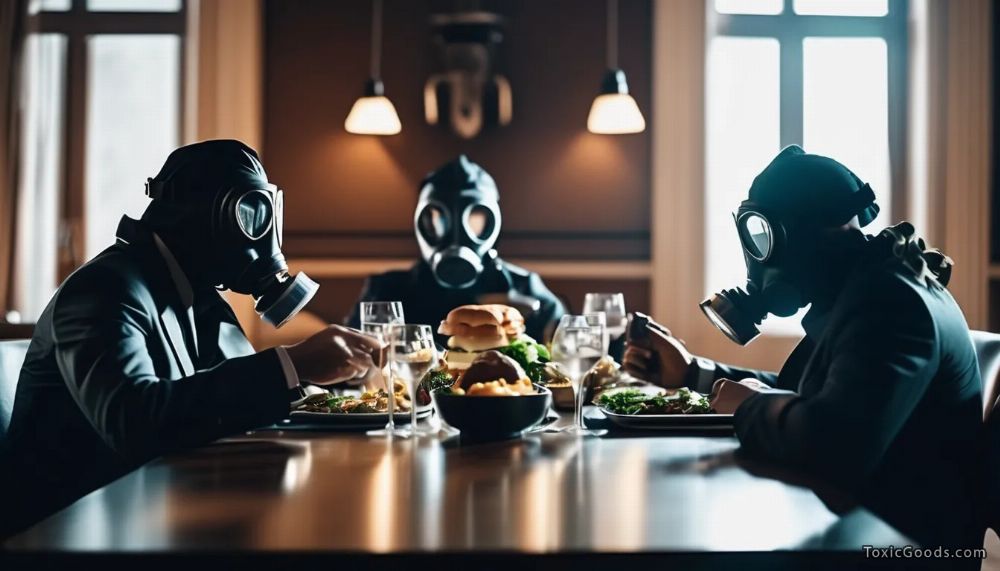HOME TOXICITY
You have your space. You feel cozy and safe.
You try to eat healthy and make others happy.
Yet you feel something is wrong…


The home air pollution is remarkably underappreciated.
Each coin has two sides. And so does the air pollution. You’ve heard about the global environmental pollution so much that it lost its importance amidst all related media attention. For that reason, the dangers of air pollution became virtually hypothetical as it didn’t seem to affect YOUR living space. It always happens “elsewhere“. But if you live in an industrialized country, use the same chemical products as everyone else – a “sick building syndrome” is about to have or has already affected your home.
Your living space is not what you believe it to be.
There are highly toxic chemicals at every home in any developed country. Some of these hazardous chemical products are household cleaners, dishwasher liquids, laundry detergents, fabric softeners, dryer sheets, air fresheners, window cleaners, all-purpose cleaners, appliance cleaners, insect killers – just to name a few. Most of them are liquid based chemicals that carry hazardous substance labels such as
- “DANGER OF POISONING”
- “FATAL IF SWALLOWED”
- “DO NOT INHALE FOR EXTENDED PERIOD OF TIME”
- “WASH SKIN THOROUGHLY AFTER HANDLING”
- “ON SKIN CONTACT, IMMEDIATELY CONSULT DOCTOR”
What do all these chemicals have in common? An extreme level of toxicity. As much as a teaspoon of most of these substances can kill you. Small amounts, such as those you inhale or otherwise come in contact with, gradually accumulate within your nerve pathways, organs, fat and muscle tissues.
Once in the body, they disrupt your critical body functions, including but not limited to hormone and neurotransmitter production, severely affecting crucial neurological processes. All the processes that are responsible for the functional health of all of your organs. This, in turn, leads to chronic, disabling and often fatal diseases.
How are these chemicals dangerous if handled properly? There is a critical piece of information that is missing on all toxic goods labels – it’s about the volatile property of these hazardous substances. “Volatile” describes any substance that is easily evaporated at normal room temperatures.


Facts about the chemical products you keep and use at your home.
1. The poisonous volatile vapors do escape the plastic containers.
When you tightly close that plastic chemical substance container thinking you have contained the liquid inside, the liquid chemicals, in fact, continue to vaporize through the plastic, contaminating not only the air you breathe but most of the things that have at home.
Every chemical’s product plastic container is porous. Plastics absorb various liquids (especially solvents and plasticizers) and are highly permeable to gasses.
If you place a plastic bottle of water next to a plastic laundry detergent container, the water will rapidly become contaminated. This is the reason why the bottled drinking water purchased at grocery stores has measurable levels of chemical contamination. Most of the drinking water is sold by retailers that concurrently sell household chemicals in the same recirculated airspace. Furthermore, the produce and even packaged foods are all contaminated along the way.
2. When you use chemicals at home, they contaminate your belongings
Once the highly volatile gasses from the chemical liquids are in the air, any porous material they come in contact with will absorb the chemicals. The porous materials include but not limited to wood, linen, rubber, most plastics, paints, some ceramics, and even metals. Once the chemicals are embedded into the materials, they will off-gas what they have absorbed.
Depending on the amount of exposure to chemical gasses, the exposed materials can continue off-gas the chemical vapors for many years, continuously poisoning the air you breathe. And you won’t even smell anything.
3. Your sense of smell will not help you to detect poisons at your home.
You enter your neighbor’s house and it’s full of odors. You get back to your home and it’s great. No detectable “aroma” or any type of odors that stand out. Does this sound familiar?
But wait… Have you ever asked yourself – “what your home smells like to others“? Or did you assume that your home is simply cleaner than ALL others you have visited?
This phenomenon is called olfactory adaptation. Your so-called “olfactory” nasal receptors simply adapt to smells that continuously present within your living environment. You lose an ability to detect consistently present in your home odors – even if they’re strong enough to cause chronic poisoning. It’s exactly the same reason why you can’t smell your body odor, your perfume (after a few minutes of application) or even your own breath.
On the brighter side, this sensory adaptation allows you to detect sudden changes in your living environment that can potentially be dangerous. Yet, a darker side of this mechanism allows you to involuntary breathe contaminated air that’s already in your home.
4. Once contaminated, the toxins are there to stay.
This might sound quite shocking, but once you use that “air freshener” or a “laundry detergent”, there will be no easy way to decontaminate your possessions that have captured the toxins. Although some chemicals are worse than others, all contaminated and toxic goods in your home (where the air is often stale and recirculated), will continue to further off-gas and poison your body through the air you breathe.
In other words -“It’s a trap, it’s toxic, and you are in it“. And unless you take steps to decontaminate your toxic home, the toxins that have already accumulated in your home will continue to irreversibly damage your health for many years to come.
"Everyone is using it" implications
With the household products market being completely overtaken by the goods from the chemical industry, we are wrongfully led to believe that these products are safe and OK to use—because “everyone is using them.”
On the contrary, a persistent flow of data reflects the terrifying consequences of using these toxic products. New, unexplained, and unpredictable diseases are overwhelming the general population at a staggering rate—diseases that have no cure and are barely managed, without a path to recovery.
